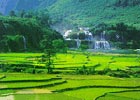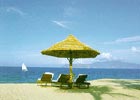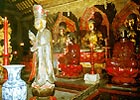 |
Top Destinations |
|
|
|
 |
Travel Tools |
|
|
|
 |
|
|
Vietnam travel information and local guide
The Socialist Republic of Vietnam, a sovereign and reunified independent
country, has a high percentage of territorial waters. Looking at the map,
Vietnam is located in the center of the Southeast Asia, and is shaped
like the letter "S". The country lies in the eastern part of
the Indochina peninsula, bordered by China to the north, Laos and Cambodia
to the west, and the East Sea and Pacific Ocean to the southeast. Vietnam's
coast line is 3,260 km long and its inland border measures 3,730 km.
The country's total length, from the northernmost point to the southernmost
point, is 1,650 km.
Its width, stretching from east to west, is 600 km at the widest point
in the north, 400 km in the south, and 50 km at the narrowest part in
the Quang Binh province on the central coast. Vietnam is also a transport
junction from the Indian Ocean to the Pacific Ocean.
 Vietnam is located in both a tropical and a temperate zone. It is characterized
by strong monsoon influences, but has a considerable amount of sun, a
high rate of rainfall, and high humidity. Regions located near the tropics
and in the mountainous regions are endowed with a temperate climate.
Vietnam is located in both a tropical and a temperate zone. It is characterized
by strong monsoon influences, but has a considerable amount of sun, a
high rate of rainfall, and high humidity. Regions located near the tropics
and in the mountainous regions are endowed with a temperate climate.
The annual average temperature ranges from 22ºC to 27ºC. In
Hanoi, the average temperature is 23ºC, in Ho Chi Minh City it is
26ºC, and in Hue it is 25ºC.
There are two distinguishable seasons. The cold season occurs from November
to April and the hot season from May to October. The difference in temperature
between the two seasons in southern Vietnam is almost unnoticeable, averaging
3ºC. The most noticeable variations are found in the northern provinces
where differences of 12ºC have been observed. There are essentially
four distinct seasons, which are most evident in the northern provinces.
 Three quarters of Vietnam's territory consists of mountains and hills.
Vietnam is divided into four distinct mountainous zones.
Three quarters of Vietnam's territory consists of mountains and hills.
Vietnam is divided into four distinct mountainous zones.
The Northeastern Zone (Viet Bac)
This zone stretches from the Red River Valley to the Gulf of Tonkin. The
mountainous area of Viet Bac is scattered with famous sights: Dong Nhat
Grotto, Dong Nhi Grotto, and Tam Thanh Grotto in Lang Son Province; Bac
Bo Grotto and Ban Gioc Waterfall in Cao Bang; Ba Be Lake in Bac Can; Yen
Tu Mountain and Halong Bay in Quang Ninh; and Tay Con Linh, the highest
mountain peak in the region reaching 2,341 meters above sea level.
The Northwestern Zone
This zone is comprised of mountains that run from the north of the Sino-Vietnamese
border to the west of Thanh Hoa Province. This magnificent mountain range
is nationally known for its resort town of Sapa in Lao Cai Province, which
is perched 1500 meters above sea level. Several ethnic groups, such as
the H'mong, Dao, Kinh, Tay, Giay, Hoa, and Xa Pho, still reside in this
region.
The northwestern zone is also famous for the historical site of Dien Bien
Phu and Fansipan Mountain, which measures 3,143 meters above sea level
at the peak.
The North Truong Son Zone
This zone runs from the western part of Thanh Hoa Province to the Quang
Nam-Da Nang Mountains. This region is known locally for its picturesque
Phong Nha Grotto and its two breathtaking passes, the Ngang Pass and the
Hai Van Pass. It is also known worldwide for being the location of the
legendary Ho Chi Minh Trail constructed during the second great resistance
war.
The South Truong Son Zone
This zone is located to the west of the south central coast provinces.
Behind these huge mountains is a vast area of red soil known locally as
"Tay Nguyen" (the Central Highlands). There are numerous legendary
accounts of the flora and fauna and of the lives of several different
ethnic minorities living in the Central Highlands. Dalat, established
during the 19th century, is a popular resort town in this part of Vietnam.
Vietnam has two major deltas, including the Red River Delta in the north
and the Mekong River Delta in the south.
The Red River Delta, or Northern Delta
This region stretches for 15,000 sq.km. Over time, deposits of alluvium
carried from the Red River and Thai Binh River have accumulated to form
the delta. The ancient Viet people settled at the junction of the two
rivers . At that time, the wet rice civilization was established
The Mekong River Delta, or Southern Delta
This region is approximately 36,000 sq. km. The land is very fertile and
has favorable climate conditions for agriculture. As a result, it is the
largest rice growing region in Vietnam.
 Vietnam is crisscrossed by thousands of streams and rivers. There is a
river discharging every 20 kilometers along Vietnam's coastline. The waterways
are a very convenient means of transport with major rivers like the Red
River in the north and the Mekong River in the south.
Vietnam is crisscrossed by thousands of streams and rivers. There is a
river discharging every 20 kilometers along Vietnam's coastline. The waterways
are a very convenient means of transport with major rivers like the Red
River in the north and the Mekong River in the south.
Vietnam's coastline is 3,260 km long. If you have a chance to travel along
the coast of Vietnam, you will be able to enjoy the beautiful beaches
of Tra Co, Sam Son, Lang Co, Non Nuoc, Nha Trang, Vung Tau, and Ha Tien.
In some places, you will see mountains jutting out to the sea. One such
magnificent site is Halong Bay, which has recently been listed as a World
Heritage Site by UNESCO.
Vietnam's coast has been awarded a series of large seaports, such as the
ones at Haiphong, Danang, Qui Nhon, Cam Ranh, Vung Tau, and Saigon. There
are thousands of islands and islets scattered offshore from north to south.
Among the most popular tourist destinations are the Truong Sa and Hoang
Sa Archipelagos.
The forests of Vietnam account for most of the total land area. National
parks are preserved by the state and follow a steady development plan.
Some of the more famous national parks located throughout the country
include Ba Vi in Ha Tay, Cat Ba in Haiphong, Cuc Phuong in Ninh Binh,
Bach Ma in Hue, and Cat Tien in Dong Nai.
Vietnam has a variety of mineral resources. Beneath the forests are valuable
minerals such as tin, zinc, silver, gold, antimony, precious stones, and
coal. Vietnam also has large deposits of oil and gas on its offshore islands
and on the mainland.
Vietnam also has abundant subterranean mineral water sources. These are
found at Quang Hanh in Quang Ninh, Hoi Van in Binh Dinh, Vinh Hao in Binh
Thuan, Duc My in Nha Trang, Kim Boi in Hoa Binh, and Binh Chau in Vung
Tau.

The major religious traditions in Vietnam are Buddhism (which fuses forms
of Taoism and Confusianism), Christianity (Catholicism and Protestantism),
Islam, Cao Daism and the Hoa Hao sect.
Language
The Vietnamese language belongs to a language group which was established
a long time ago in East Asia. Changes in material conditions over many
centuries and the increasing demands of cultural life have influenced
the Vietnamese language.
While adopting many elements of the Chinese language, the Vietnamese
people changed many Chinese words, gradually creating Han-Viet (Chinese-Vietnamese)
which incorporated purely Vietnamese words. "Vietnamization"
not only applied to the Chinese language, but also to French and other
language groups, creating a diverse vocabulary for the Vietnamese language.
Written
 When
the multi-ethnic Vietnamese nation was taking shape, a great monarchy
was established in the North, and it began a southward expansion. The
Vietnamese nation underwent thousands of years of Northern domination.
This was why Chinese was used for a long time as the official written
language. Local mandarins of various levels were allowed to sit for examinations
in the Northern Court (China), and were recruited into the administrative
machinery of foreign invaders. When
the multi-ethnic Vietnamese nation was taking shape, a great monarchy
was established in the North, and it began a southward expansion. The
Vietnamese nation underwent thousands of years of Northern domination.
This was why Chinese was used for a long time as the official written
language. Local mandarins of various levels were allowed to sit for examinations
in the Northern Court (China), and were recruited into the administrative
machinery of foreign invaders.
Based on Chinese characters, the Vietnamese worked out a unique writing
system of their own called Chu Nom. In Chu Nom, two Chinese characters
were usually combined, one of which indicated the meaning of the Vietnamese
word, while the other indicated pronunciation. Chu Nom was welcomed and
widely used by the masses in their daily life, as well as in transcribing
their national history and literature. According to researchers, Chu Nom
probably originated around the end of the Northern domination period and
early in the 10th century (the independence period). The oldest evidence
of Chu Nom currently available is a stele in the Bao An Pagoda in Yen
Lang, Vinh Phu province, dating back to 1209 AD (Ly Dynasty). It was not
until the 13th century under the Tarn dynasty that Chu Nom was systematized
and used in literature.
Nguyen Thuyen (alias Han Thuyen) and Nguyen Si Co wrote poems in Chu
Nom. Ho Quy Ly (1400 AD) made Chinese textbooks which translated the Vietnamese
language using the Chu Nom writing system. He also used Chu Nom to write
royal proclamations and ordinances. In the 15th century, Nguyen Trai,
a national hero, used Chu Nom to write 250 poems in Quoc Am Thi Tap (Collection
of Poems in the National Language). The Chu Nom literature continued to
be developed from the 16th century onwards and totally dominated national
literary circles. Ba Huyen Thanh Quan (the wife of the Chief of Thanh
Quan district), Cao Ba Quat and Kieu Story of Nguyen Du, and the translation
of Chinh Phu Ngam (Lament of a Wife Whose Husband has Gone to War) by
Doan Thi Diem were quite noteworthy poems.
In conjunction with the development of the nation, the Vietnamese language
was constantly developed and improved. Around the 17th century, western
missionaries came to Vietnam and learned Vietnamese in order to disseminate
Catholicism. They developed a romanced script to represent the Quoc Ngu
(meaning national language) in order to translate prayer books and catechisms.
A number of Portuguese and Italian missionaries used Quoc Ngu to compile
catechisms and Portuguese-Vietnamese and Vietnamese-Portuguese dictionaries.
Based on these works, Alexandre de Rhodes, a French Jesuit missionary,
published the Vietnamese Portuguese-Latin dictionary which was a fundamental
catechism in Rome from 1649-1651. After Alexandre de Rhodes, Quoc Ngu
was further improved by foreign missionaries and Vietnamese scholars.
In 1867, some colonial schools began to teach Quoc Ngu. It was not until
early in the 20th century that Quoc Ngu became widely used in the local
primary educational system. The introduction of Quoc Ngu constituted a
new step in the development of the Vietnamese language. While romanization
received a reserved welcome in other Asian countries, it recorded extraordinary
success in Vietnam, creating favorable conditions for cultural and intellectual
development.
|
|
 |
Travel
Guides |
|
|
 |
|

